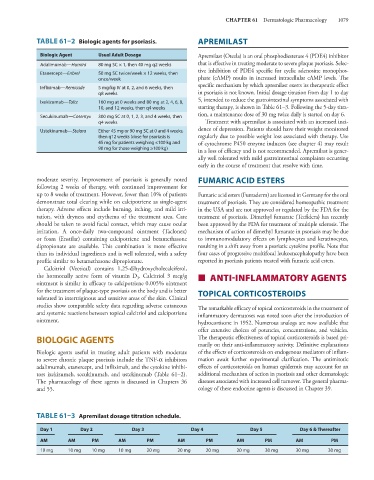Page 1093 - Basic _ Clinical Pharmacology ( PDFDrive )
P. 1093
CHAPTER 61 Dermatologic Pharmacology 1079
TABLE 61–2 Biologic agents for psoriasis. APREMILAST
Biologic Agent Usual Adult Dosage Apremilast (Otezla) is an oral phosphodiesterase 4 (PDE4) inhibitor
Adalimumab—Humira 80 mg SC × 1, then 40 mg q2 weeks that is effective in treating moderate to severe plaque psoriasis. Selec-
tive inhibition of PDE4 specific for cyclic adenosine monophos-
Etanercept—Enbrel 50 mg SC twice/week × 12 weeks, then
once/week phate (cAMP) results in increased intracellular cAMP levels. The
specific mechanism by which apremilast exerts its therapeutic effect
Infliximab—Remicade 5 mg/kg IV at 0, 2, and 6 weeks, then
q8 weeks in psoriasis is not known. Initial dosage titration from day 1 to day
Ixekizumab—Taltz 160 mg at 0 weeks and 80 mg at 2, 4, 6, 8, 5, intended to reduce the gastrointestinal symptoms associated with
10, and 12 weeks, then q4 weeks starting therapy, is shown in Table 61–3. Following the 5-day titra-
Secukinumab—Cosentyx 300 mg SC at 0, 1, 2, 3, and 4 weeks, then tion, a maintenance dose of 30 mg twice daily is started on day 6.
q4 weeks Treatment with apremilast is associated with an increased inci-
Ustekinumab—Stelara Either 45 mg or 90 mg SC at 0 and 4 weeks, dence of depression. Patients should have their weight monitored
then q12 weeks (dose for psoriasis is regularly due to possible weight loss associated with therapy. Use
45 mg for patients weighing ≤100 kg and of cytochrome P450 enzyme inducers (see chapter 4) may result
90 mg for those weighing ≥100 kg)
in a loss of efficacy and is not recommended. Apremilast is gener-
ally well tolerated with mild gastrointestinal complaints occurring
early in the course of treatment that resolve with time.
moderate severity. Improvement of psoriasis is generally noted FUMARIC ACID ESTERS
following 2 weeks of therapy, with continued improvement for
up to 8 weeks of treatment. However, fewer than 10% of patients Fumaric acid esters (Fumaderm) are licensed in Germany for the oral
demonstrate total clearing while on calcipotriene as single-agent treatment of psoriasis. They are considered homeopathic treatment
therapy. Adverse effects include burning, itching, and mild irri- in the USA and are not approved or regulated by the FDA for the
tation, with dryness and erythema of the treatment area. Care treatment of psoriasis. Dimethyl fumarate (Tecfidera) has recently
should be taken to avoid facial contact, which may cause ocular been approved by the FDA for treatment of multiple sclerosis. The
irritation. A once-daily two-compound ointment (Taclonex) mechanism of action of dimethyl fumarate in psoriasis may be due
or foam (Enstilar) containing calcipotriene and betamethasone to immunomodulatory effects on lymphocytes and keratinocytes,
dipropionate are available. This combination is more effective resulting in a shift away from a psoriatic cytokine profile. Note that
than its individual ingredients and is well tolerated, with a safety four cases of progressive multifocal leukoencephalopathy have been
profile similar to betamethasone dipropionate. reported in psoriasis patients treated with fumaric acid esters.
Calcitriol (Vectical) contains 1,25-dihydroxycholecalciferol,
. Calcitriol 3 mcg/g
the hormonally active form of vitamin D 3 ■ ANTI-INFLAMMATORY AGENTS
ointment is similar in efficacy to calcipotriene 0.005% ointment
for the treatment of plaque-type psoriasis on the body and is better TOPICAL CORTICOSTEROIDS
tolerated in intertriginous and sensitive areas of the skin. Clinical
studies show comparable safety data regarding adverse cutaneous The remarkable efficacy of topical corticosteroids in the treatment of
and systemic reactions between topical calcitriol and calcipotriene inflammatory dermatoses was noted soon after the introduction of
ointment. hydrocortisone in 1952. Numerous analogs are now available that
offer extensive choices of potencies, concentrations, and vehicles.
BIOLOGIC AGENTS The therapeutic effectiveness of topical corticosteroids is based pri-
marily on their anti-inflammatory activity. Definitive explanations
Biologic agents useful in treating adult patients with moderate of the effects of corticosteroids on endogenous mediators of inflam-
to severe chronic plaque psoriasis include the TNF-α inhibitors mation await further experimental clarification. The antimitotic
adalimumab, etanercept, and infliximab, and the cytokine inhibi- effects of corticosteroids on human epidermis may account for an
tors ixekizumab, secukinumab, and ustekinumab (Table 61–2). additional mechanism of action in psoriasis and other dermatologic
The pharmacology of these agents is discussed in Chapters 36 diseases associated with increased cell turnover. The general pharma-
and 55. cology of these endocrine agents is discussed in Chapter 39.
TABLE 61–3 Apremilast dosage titration schedule.
Day 1 Day 2 Day 3 Day 4 Day 5 Day 6 & Thereafter
AM AM PM AM PM AM PM AM PM AM PM
10 mg 10 mg 10 mg 10 mg 20 mg 20 mg 20 mg 20 mg 30 mg 30 mg 30 mg

